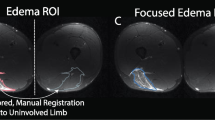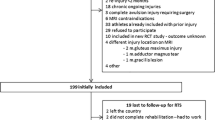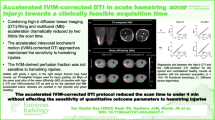Abstract
Objective
To determine if MRI-based radiomics from hamstring muscles are related to injury and if the features could be used to perform a time to return to sport (RTS) classification. We hypothesize that radiomics from hamstring muscles, especially T2-weighted and diffusion tensor imaging-based features, are related to injury and can be used for RTS classification.
Subjects and methods
MRI data from 32 athletes at the University of Wisconsin-Madison that sustained a hamstring strain injury were collected. Diffusion tensor imaging and T1- and T2-weighted images were processed, and diffusion maps were calculated. Radiomics features were extracted from the four hamstring muscles in each limb and for each MRI modality, individually. Feature selection was performed and multiple support vector classifiers were cross-validated to differentiate between involved and uninvolved limbs and perform binary (≤ or > 25 days) and multiclass (< 14 vs. 14—42 vs. > 42 days) classification of RTS.
Result
The combination of radiomics features from all diffusion tensor imaging and T2-weighted images provided the most accurate differentiation between involved and uninvolved limbs (AUC ≈ 0.84 ± 0.16). For the binary RTS classification, the combination of all extracted radiomics offered the most accurate classification (AUC ≈ 0.95 ± 0.15). While for the multiclass RTS classification, the combination of features from all the diffusion tensor imaging maps provided the most accurate classification (weighted one vs. rest AUC ≈ 0.81 ± 0.16).
Conclusion
This pilot study demonstrated that radiomics features from hamstring muscles are related to injury and have the potential to predict RTS.




Similar content being viewed by others
Data availability
The data in support of the findings of this study is not publicly available and cannot be shared due to Institutional Review Board’s restrictions.
References
Opar DA, Williams MD, Shield AJ. Hamstring Strain Injuries: Factors that Lead to Injury and Re-Injury. Sports Med. 2012;42:209–26.
Feeley BT, Kennelly S, Barnes RP, Muller MS, Kelly BT, Rodeo SA, et al. Epidemiology of National Football League Training Camp Injuries from 1998 to 2007. Am J Sports Med. 2008;36:1597–603.
Dalton SL, Kerr ZY, Dompier TP. Epidemiology of Hamstring Strains in 25 NCAA Sports in the 2009–2010 to 2013–2014 Academic Years. Am J Sports Med. 2015;43:2671–9.
Malliaropoulos N, Papacostas E, Kiritsi O, Rad P-M, Papalada A, Gougoulias N, et al. Posterior Thigh Muscle Injuries in Elite Track and Field Athletes. Am J Sports Med. 2010;38:1813–9.
Verrall GM, Kalairajah Y, Slavotinek JP, Spriggins AJ. Assessment of player performance following return to sport after hamstring muscle strain injury. J Sci Med Sport. 2006;9:87–90.
Connell DA, Schneider-Kolsky ME, Hoving JL, Malara F, Buchbinder R, Koulouris G, et al. Longitudinal Study Comparing Sonographic and MRI Assessments of Acute and Healing Hamstring Injuries. Am J Roentgenol. 2004;183:975–84.
Pieters D, Wezenbeek E, Schuermans J, Witvrouw E. Return to Play After a Hamstring Strain Injury: It is Time to Consider Natural Healing. Sports Med. 2021;51:2067–77.
van der Horst N, van de Hoef S, Reurink G, Huisstede B, Backx F. Return to Play After Hamstring Injuries: A Qualitative Systematic Review of Definitions and Criteria. Sports Med. 2016;46:899–912.
de Visser H, Reijman M, Heijboer M, Bos P. Risk factors of recurrent hamstring injuries: a systematic review. Br J Sports Med. 2012;46:124–30.
Schut L, Wangensteen A, Maaskant J, Tol JL, Bahr R, Moen M. Can Clinical Evaluation Predict Return to Sport after Acute Hamstring Injuries? A Systematic Review. Sports Med. 2017;47:1123–44.
Hamilton B, Wangensteen A, Whiteley R, Almusa E, Geertsema L, Targett S, et al. Cohen’s MRI scoring system has limited value in predicting return to play. Knee Surg Sports Traumatol Arthrosc. 2018;26:1288–94. https://doi.org/10.1007/s00167-016-4403-8.
Reurink G, Brilman EG, de Vos R-J, Maas M, Moen MH, Weir A, et al. Magnetic Resonance Imaging in Acute Hamstring Injury: Can We Provide a Return to Play Prognosis? Sports Med. 2015;45:133–46.
Svensson K, Alricsson M, Eckerman M, Magounakis T, Werner S. The correlation between the imaging characteristics of hamstring injury and time required before returning to sports: a literature review. J Exerc Rehabil. 2016;12:134–42.
Ekstrand J, Healy JC, Waldén M, Lee JC, English B, Hägglund M. Hamstring muscle injuries in professional football: the correlation of MRI findings with return to play. Br J Sports Med. 2012;46:112–7.
van Heumen M, Tol JL, de Vos R-J, Moen MH, Weir A, Orchard J, et al. The prognostic value of MRI in determining reinjury risk following acute hamstring injury: a systematic review. Br J Sports Med. 2017;51:1355–63.
Rudisill SS, Kucharik MP, Varady NH, Martin SD. Evidence-Based Management and Factors Associated With Return to Play After Acute Hamstring Injury in Athletes: A Systematic Review. Orthop J Sports Med. 2021;9:23259671211053830.
Jacobsen P, Witvrouw E, Muxart P, Tol JL, Whiteley R. A combination of initial and follow-up physiotherapist examination predicts physician-determined time to return to play after hamstring injury, with no added value of MRI. Br J Sports Med. 2016;50:431–9.
Wangensteen A, Tol JL, Witvrouw E, Van Linschoten R, Almusa E, Hamilton B, et al. Hamstring Reinjuries Occur at the Same Location and Early After Return to Sport: A Descriptive Study of MRI-Confirmed Reinjuries. Am J Sports Med. 2016;44:2112–21.
Biglands JD, Grainger AJ, Robinson P, Tanner SF, Tan AL, Feiweier T, et al. MRI in acute muscle tears in athletes: can quantitative T2 and DTI predict return to play better than visual assessment? Eur Radiol. 2020;30:6603–13.
McAleer S, Macdonald B, Lee J, Zhu W, Giakoumis M, Maric T, et al. Time to return to full training and recurrence of rectus femoris injuries in elite track and field athletes 2010–2019; a 9-year study using the British Athletics Muscle Injury Classification. Scand J Med Sci Sports. 2022;32:1109–18.
Pollock N, Patel A, Chakraverty J, Suokas A, James SLJ, Chakraverty R. Time to return to full training is delayed and recurrence rate is higher in intratendinous ('c’) acute hamstring injury in elite track and field athletes: clinical application of the British Athletics Muscle Injury Classification. Br J Sports Med. 2016;50:305–10.
Shamji R, James SLJ, Botchu R, Khurniawan KA, Bhogal G, Rushton A. Association of the British Athletic Muscle Injury Classification and anatomic location with return to full training and reinjury following hamstring injury in elite football. BMJ Open Sport Exerc Med. 2021;7:e001010.
Tears C, Rae G, Hide G, Sinha R, Franklin J, Brand P, et al. The British Athletics Muscle Injury Classification grading system as a predictor of return to play following hamstrings injury in professional football players. Phys Ther Sport. 2022;58:46–51.
Green B, Bourne MN, van Dyk N, Pizzari T. Recalibrating the risk of hamstring strain injury (HSI): A 2020 systematic review and meta-analysis of risk factors for index and recurrent hamstring strain injury in sport. Br J Sports Med. 2020;54:1081–8.
Gillies RJ, Kinahan PE, Hricak H. Radiomics: Images Are More than Pictures, They Are Data. Radiology. 2016;278:563–77.
Rizzo S, Botta F, Raimondi S, Origgi D, Fanciullo C, Morganti AG, et al. Radiomics: the facts and the challenges of image analysis. Eur Radiol Exp. 2018;2:36.
Li X, Morgan PS, Ashburner J, Smith J, Rorden C. The first step for neuroimaging data analysis: DICOM to NIfTI conversion. J Neurosci Methods. 2016;264:47–56.
Jenkinson M, Beckmann CF, Behrens TEJ, Woolrich MW, Smith SM. FSL. NeuroImage. 2012;62:782–90.
Smith SM, Jenkinson M, Woolrich MW, Beckmann CF, Behrens TEJ, Johansen-Berg H, et al. Advances in functional and structural MR image analysis and implementation as FSL. Neuroimage. 2004;23:S208–19.
Woolrich MW, Jbabdi S, Patenaude B, Chappell M, Makni S, Behrens T, et al. Bayesian analysis of neuroimaging data in FSL. Neuroimage. 2009;45:S173–86.
McCarthy P. Source code for: FSLeyes. Zenodo; 2019. Available from: https://doi.org/10.5281/zenodo.3530921.
van Griethuysen JJM, Fedorov A, Parmar C, Hosny A, Aucoin N, Narayan V, et al. Computational Radiomics System to Decode the Radiographic Phenotype. Can Res. 2017;77:e104–7.
Tixier F, Le Rest CC, Hatt M, Albarghach N, Pradier O, Metges J-P, et al. Intratumor Heterogeneity Characterized by Textural Features on Baseline 18 F-FDG PET Images Predicts Response to Concomitant Radiochemotherapy in Esophageal Cancer. J Nucl Med. 2011;52:369–78.
Pedregosa F, Varoquaux G, Gramfort A, Michel V, Thirion B, Grisel O, et al. Scikit-learn: Machine Learning in Python. J Mach Learn Res. 2011;12:2825–30.
Efron B. Bootstrap methods: another look at the jackknife. Ann Statist. 1979;7:1–26. https://doi.org/10.1214/aos/1176344552.full.
Virtanen P, Gommers R, Oliphant TE, Haberland M, Reddy T, Cournapeau D, et al. SciPy 1.0: fundamental algorithms for scientific computing in Python. Nat Methods. 2020;17:261–72.
Friedman M. The Use of Ranks to Avoid the Assumption of Normality Implicit in the Analysis of Variance. J Am Stat Assoc. 1937;32:675–701.
Friedman M. A Correction. J Am Stat Assoc. 1939;34:109–109.
Friedman M. A Comparison of Alternative Tests of Significance for the Problem of m Rankings. Ann Math Statist. 1940;11:86–92.
Conover WJ. Practical nonparametric statistics. 3rd ed. Wiley; 1999.
Wille C, Hurley SA, Adluru N, Alcock R, Heiderscheit BC, Kijowski R. Quantitative muscle microstructural changes detected with diffusion tensor imaging following acute hamstring strain injuries. In: Proceedings of the Radiological Society of North America Annual Meeting. 2019. Available from: https://archive.rsna.org/2019/19014912.html.
Greenky M, Cohen S. Magnetic resonance imaging for assessing hamstring injuries: clinical benefits and pitfalls – a review of the current literature. OAJSM. 2017;8:167–70.
Froeling M, Oudeman J, Strijkers GJ, Maas M, Drost MR, Nicolay K, et al. Muscle Changes Detected with Diffusion-Tensor Imaging after Long-Distance Running. Radiology. 2015;274:548–62.
Hooijmans MT, Monte JRC, Froeling M, Berg-Faay S, Aengevaeren VL, Hemke R, et al. Quantitative MRI Reveals Microstructural Changes in the Upper Leg Muscles After Running a Marathon. J Magn Reson Imaging. 2020;52:407–17.
Van Donkelaar CC, Kretzers LJG, Bovendeerd PHM, Lataster LMA, Nicolay K, Janssen JD, et al. Diffusion tensor imaging in biomechanical studies of skeletal muscle function. J Anatomy. 1999;194:79–88.
Hallén A, Ekstrand J. Return to play following muscle injuries in professional footballers. J Sports Sci. 2014;32:1229–36.
Kilcoyne KG, Dickens JF, Keblish D, Rue J-P, Chronister R. Outcome of Grade I and II Hamstring Injuries in Intercollegiate Athletes: A Novel Rehabilitation Protocol. Sports Health. 2011;3:528–33.
Gidwani M, Chang K, Patel JB, Hoebel KV, Ahmed SR, Singh P, et al. Inconsistent Partitioning and Unproductive Feature Associations Yield Idealized Radiomic Models. Radiology. 2023;307:e220715.
Acknowledgements
This work is supported by NBA and GE Healthcare Orthopedics and Sports Medicine Collaboration (MYT-015, D223) and NIH awards TL1TR002375 and R01EB026708. The authors would like to acknowledge the Sports Medicine staff in the University of Wisconsin-Madison Division of Athletics for their commitment to the welfare of the student-athletes and contributions to the Badger Athletic Performance program.
Author information
Authors and Affiliations
Corresponding author
Ethics declarations
Conflict of interest
The authors declare that they have no conflict of interest.
Additional information
Publisher's note
Springer Nature remains neutral with regard to jurisdictional claims in published maps and institutional affiliations.
Supplementary information
Below is the link to the electronic supplementary material.
Rights and permissions
Springer Nature or its licensor (e.g. a society or other partner) holds exclusive rights to this article under a publishing agreement with the author(s) or other rightsholder(s); author self-archiving of the accepted manuscript version of this article is solely governed by the terms of such publishing agreement and applicable law.
About this article
Cite this article
Torres-Velázquez, M., Wille, C.M., Hurley, S.A. et al. MRI radiomics for hamstring strain injury identification and return to sport classification: a pilot study. Skeletal Radiol 53, 637–648 (2024). https://doi.org/10.1007/s00256-023-04449-7
Received:
Revised:
Accepted:
Published:
Issue Date:
DOI: https://doi.org/10.1007/s00256-023-04449-7




